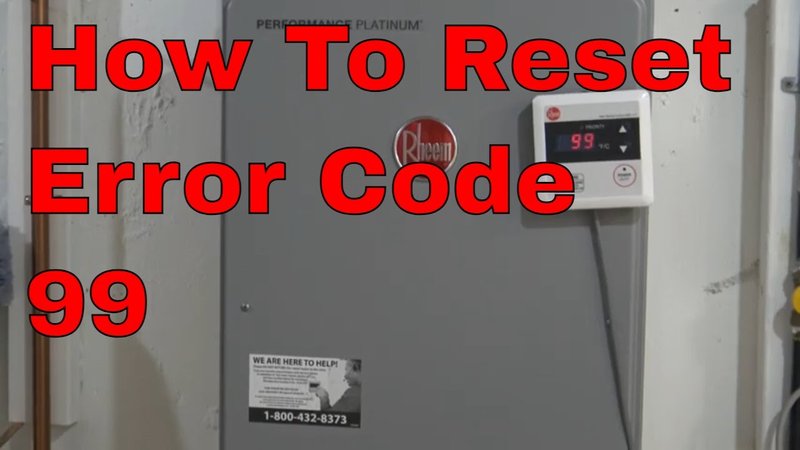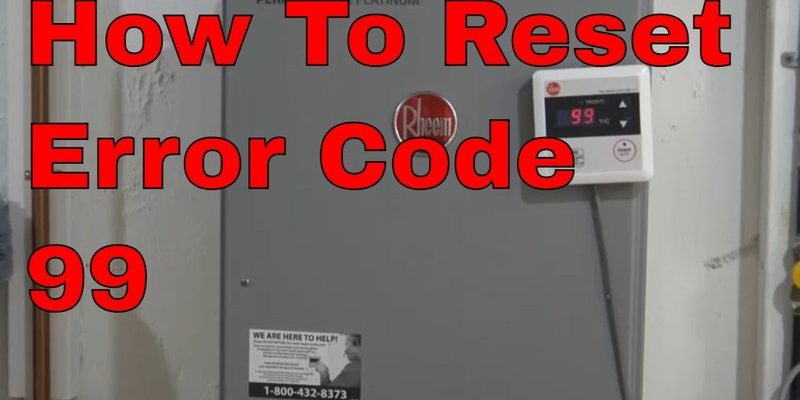
Here’s the deal: when your Rheem water heater shows an Error Code “Le,” it’s basically waving a little red flag indicating there’s a leak detection problem. This can be due to several reasons, ranging from a minor glitch to a more serious mechanical issue. But fear not! Armed with the right knowledge and a bit of patience, you can reset your Rheem water heater and get it back in working order. Let’s dive into what steps you need to take, and soon enough, you’ll be back to enjoying hot showers.
Understanding Error Code “Le” on Your Rheem Water Heater
Before we jump into fixing the issue, it’s crucial to understand what Error Code “Le” means. Your Rheem water heater is equipped with a system to detect leaks, and this error is typically an indication from the onboard diagnostics that there might be a leak somewhere. Think of it like your car’s check engine light turning on — it’s a signal to investigate further.
Error Code “Le” can occur for various reasons. It might be due to a loose or faulty wiring connection, which essentially means the system isn’t able to accurately determine whether a leak is present. Alternatively, it could be tripped by an actual water leak, which, if left unchecked, could lead to water damage in your home. In some cases, the error code might pop up due to a sensor malfunction. Regardless of the cause, it’s essential to address the situation promptly.
So, what should you do when faced with this error? First, don’t panic. Tackling this problem is often a straightforward process. With a little troubleshooting, you can determine the root cause and decide whether you can resolve it yourself or if it’s time to call in a professional. Always ensure your safety; if you’re ever in doubt, hiring a certified technician is your best bet.
Step-by-Step Guide to Resetting Your Rheem Water Heater
Now that you understand why Error Code “Le” appears, let’s walk through the steps to reset your Rheem water heater. The goal here is to return the unit to its normal operation, and often, resetting is all it takes.
First, start by turning off the power to the water heater. This is a crucial safety step. Locate the circuit breaker panel in your home, usually found in the basement, garage, or utility area. Find the switch labeled “Water Heater” and flip it to the *off* position. This ensures there’s no electricity running to your unit while you’re working on it.
Next, examine the area around the water heater for any visible leaks. If you notice water pooling or dripping, this might be the source of your error code. Fixing a leak could be as simple as tightening a loose valve or replacing a worn-out gasket. However, if it appears more serious or if water is coming from within the unit, it’s wise to call a professional plumber to avoid causing further damage.
Once you’ve inspected for leaks, if everything seems in order, proceed to reset the system. Turn the circuit breaker back to the *on* position and power up your water heater. Most models will require a reset button to be pressed to clear the error code. This button is typically located on the thermostat. Refer to your Rheem water heater manual for exact instructions, as the reset button location can vary depending on the model.
Troubleshooting Persistent Issues
Sometimes, even after resetting your water heater, the Error Code “Le” could persist. If that’s the case, deeper investigation is needed. Start by checking all the wiring connections. A loose or corroded wire might be causing intermittent communication issues with the leak detection sensors. Like fixing a loose headphone jack, securing these connections might solve the problem.
Another potential cause could be a malfunctioning sensor. Sensors can sometimes wear out or become faulty, much like a smoke detector that needs new batteries. If you suspect this is the issue, replacing the sensor could help. Again, consulting your manual or contacting a professional for assistance is recommended if you’re not comfortable doing this yourself.
Lastly, consider the age and condition of your water heater. If it’s an older model, wear and tear could be contributing to recurring issues. While modern heaters are designed to last, parts can degrade over time, leading to errors such as this one. In such cases, discussing long-term solutions with a qualified technician might be the best course of action, possibly considering an upgrade or replacement of the unit.
Preventative Tips to Avoid Future Error Codes
Nobody likes dealing with sudden cold showers or error codes, so taking preventative steps can be a game-changer. Regular maintenance of your water heater can prevent many common issues and extend its lifespan.
Consider scheduling annual inspections with a qualified technician. Regular check-ups help catch potential problems before they turn into bigger headaches. Much like a yearly tune-up for your car, this proactive approach ensures everything runs smoothly and efficiently.
Additionally, pay attention to any unusual noises or performance issues with your water heater. These could be early warning signs of something going awry. Addressing such signs early on can prevent more significant problems down the road, much like treating a small leak in the roof before it becomes a flood.
Lastly, always ensure your water heater is installed correctly and in a location where leaks won’t cause significant damage. If you’re upgrading or installing a new unit, consider hiring a professional to ensure it’s set up properly. By following these tips, you’re less likely to encounter unexpected disruptions and more likely to enjoy seamless access to hot water.
By taking these thoughtful steps, you’ll not only resolve the immediate issue but also set yourself up for smoother sailing in the future. Remember, when in doubt, never hesitate to call a professional to help keep your home warm and comfortable.
